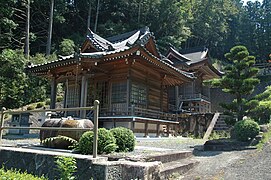Sanno Gongen
Sanno Gongen is a Japanese syncretic Buddhist Shinto deity[1] ja:山王権現
History[edit]
In 788 AD, Saichō erected the Tendai Buddhist temple complex of Enryaku-ji on Mount Hiei. After the transfer of the capital to Heian-kyō, Enryaku-ji and by extension, Hiyoshi Taisha came to be guardians of the spiritually vulnerable northeast quadrant from the capital. As Enryaku-ji became ever more powerful, and the Buddhist faith gradually amalgamated with Shinto under the Shinbutsu-shūgō policy, Hiyoshi Taisha was subsumed into Enryaku-ji. As missionaries from Enryaku-ji built Buddhist temples all across Japan, they also spread the faith in the "Sanno Gongen" and the Hie kami.
The practice was stopped in 1571 when Oda Nobunaga ordered Enryaku-ji to be razed to the ground, and all of its monks to be massacred. This also included Hie Taisha. The shrine was rebuilt under Toyotomi Hideyoshi, with the oldest buildings currently at the shrine dating from the period of 1586 to 1597. Toyotomi Hideyoshi had a deep faith in the Sanno Gongen, as his childhood name was "Hiyoshi Maru" and his nickname was "monkey", an animal which was considered to be the spiritual messenger of the Hie kami. The Nishi Hongū was reconstructed in 1586 and the Higashi Hongū in 1595. Tokugawa Ieyasu also had faith in the Sanno Gongen and the shrine was supported by the Tokugawa shogunate.
Gallery[edit]
-
Hariti Hall(Kanshin-ji)
-
Chinju-dō、Dō、Homa(Gahaishizan Mandaraji Temple)
See Also[edit]
References[edit]
- ↑ "Sanno Gongen Shrine | The Landmarks of Edo in Color Woodblock Prints". www.ndl.go.jp. Retrieved 2023-10-06.
This article "Sanno Gongen" is from Wikipedia. The list of its authors can be seen in its historical and/or the page Edithistory:Sanno Gongen. Articles copied from Draft Namespace on Wikipedia could be seen on the Draft Namespace of Wikipedia and not main one.


](https://upload.wikimedia.org/wikipedia/commons/thumb/9/9c/%E4%B8%83%E5%AE%9D%E7%80%A7%E5%AF%BA%E9%8E%AE%E5%AE%88%E5%A0%82_%E6%B3%89%E4%BD%90%E9%87%8E%E5%B8%82_2013.11.23_-_panoramio.jpg/272px-%E4%B8%83%E5%AE%9D%E7%80%A7%E5%AF%BA%E9%8E%AE%E5%AE%88%E5%A0%82_%E6%B3%89%E4%BD%90%E9%87%8E%E5%B8%82_2013.11.23_-_panoramio.jpg)


